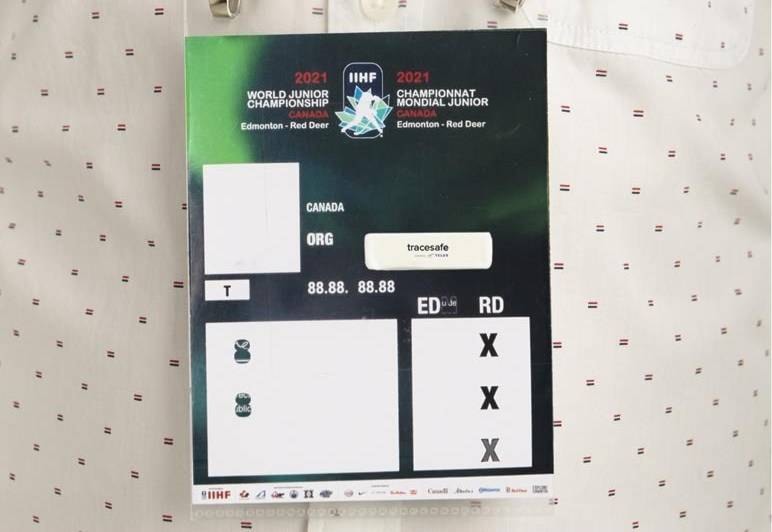What looks like a thin pack of gum is attached to Braden Schneider’s event credential at the world junior hockey championship in Edmonton.
It’s a beacon providing both contact-tracing capability should the Canadian defenceman test positive for the COVID-19 virus, and a warning if he stands too close to someone else for too long.
“It’s a mandatory thing to make sure we’re all safe in these times,” Schneider said. “If that’s one of the things we have to do, we’re very privileged and lucky to even get the chance to come here and play.”
TraceSafe’s wearable technology is Hockey Canada’s extra layer of defence against the spread of the virus in the world junior tournament, in addition to the same cellphone app the NHL used in its Edmonton and Toronto playoff “bubbles” this year.
That app, which includes facial recognition technology, is a self-assessment tool that provides a code for a temperature check if a person is feeling feverish.
The Bluetooth beacon on Schneider’s credential features a small red light that flashes if he’s less than two metres from another person, or if he’s in someone else’s presence for more than 15 minutes.
Data is uploaded via an encrypted network to be used for contact tracing in the event of a positive test for the virus.
“What we wanted to do is be able to trace where people were relative to others and we wanted to be able to set a quarantine period where no one was allowed to leave,” said Hockey Canada vice-president of events Dean McIntosh.
“The app didn’t do that for us and neither did the daily testing, so there was a need to find something different and new.
“We were pleased it was cutting edge and taking the bubble a little further than what the NHL did knowing that we were in a situation where certainly the cases of COVID in the province were higher than they were in August. We felt we needed to be a little more detailed.”
The technology works in concert with other measures, including daily testing. Hockey Canada hired the same private Edmonton lab the NHL did to process tests.
Wearing masks is mandatory. They are removed when players and personnel are about to step on the ice, McIntosh said.
The trickiest part of managing the virus was when the 10 teams arrived in Edmonton on Dec. 13.
Everyone wore a wristband resembling a hospital bracelet while quarantined in their hotel rooms for five days.
A gateway, or a small hardware device in their rooms, and the wristbands created a geofence.
If a player left his room, the signal would break and indicate a breach of quarantine.
Those deemed free of the virus after quarantine discarded the wristbands and donned credentials with the beacons to enter the world junior “bubble”.
Nine German players continued wearing wristbands and isolating in their hotel rooms several more days because of positive tests during quarantine. One player will continue to do so until Jan. 4.
Players can take off their credential when they change out of street clothes into hockey gear, McIntosh said.
Who sees the data? An International Ice Hockey Federation official and a representative of the organizing committee can access it in real time.
A 16-member compliance committee made up of representatives from all 10 teams, officials and the host broadcaster regularly meets to discuss any violations of COVID-19 protocols, McIntosh said.
A positive test gets reported to Alberta Health Services for contact tracing to commence.
“We have not had a case since individuals came out of quarantine, so we haven’t had to utilize the TraceSafe technology to identify close contacts in a positive case in the bubble,” McIntosh said.
The credential beacon doesn’t create a geofence barrier. More traditional measures ensure no one leaves the hotel or arena to walk through downtown Edmonton.
“Our security in our hotels and the non-technological ways we keep them in with fencing around the hotels have been a way to manage that,” McIntosh said.
“I don’t think it’s a lack of trust, but there does come a point in the event where teams will be eliminated and maybe here for 24 hours before they leave, so we’re really trying to ensure the temptation of leaving the bubble isn’t there either.”
Employers such as construction companies now use TraceSafe wearables, chief executive officer Wayne Lloyd said.
Another sports application is Boston’s TD Garden, the home of the NBA’s Celtics and the NHL’s Bruins, which has 500 arena employees wearing the technology.
“We don’t know when health authorities are going to give the green light to start allowing fans back in,” Lloyd said.
“Whether wearables are a part of the fan journey, that’s a very open question as well. I don’t know what that looks like, so I wouldn’t want to speculate.
“Most of the conversations have been strictly around employers and how they can work together with us.”
Donna Spencer, The Canadian Press
Like us on Facebook and follow us on Twitter.
Want to support local journalism? Make a donation here.
